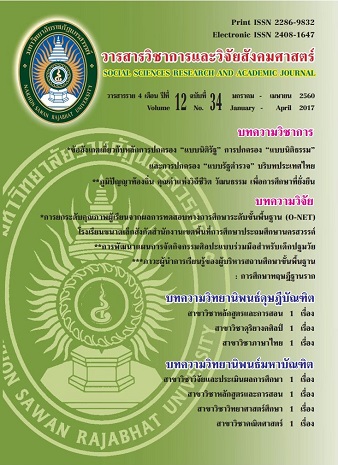ปัจจัยจำแนกความสามารถในการคิดวิเคราะห์ทางคณิตศาสตร์สูงและต่ำ และแนวทางการส่งเสริมและพัฒนาความสามารถในการคิดวิเคราะห์ สำหรับนักเรียนชั้นมัธยมศึกษาปีที่ 1 จังหวัดยโสธร; Discriminant Factors of High and Low Mathematics Analytical Thinking Ability and Ways t
Main Article Content
Abstract
บทคัดย่อ
การวิจัยครั้งนี้มีวัตถุประสงค์ เพื่อศึกษาปัจจัยจำแนกความสามารถในการคิดวิเคราะห์ทางคณิตศาสตร์ เพื่อสร้างสมการจำแนกกลุ่มนักเรียนที่มีความสามารถในการคิดวิเคราะห์ทางคณิตศาสตร์สูงและต่ำ และเพื่อเสนอแนวทางการส่งเสริมและพัฒนาความสามารถในการคิดวิเคราะห์ทางคณิตศาสตร์ กลุ่มตัวอย่าง ได้แก่ นักเรียน
ชั้นมัธยมศึกษาปีที่ 1 ปีการศึกษา 2558 จำนวน 476 คน ในจังหวัดยโสธร ที่ได้มาโดยการสุ่มแบบหลายขั้นตอน (Multi-Stage Random Sampling) และครูผู้ สอนสาระการเรียนรู้คณิตศาสตร์ จำนวน 5 คน ที่ได้มาโดยการเลือกแบบเจาะจง (Purposive Sampling) เครื่องมือที่ใช้เก็บรวบรวมข้อมูล ได้แก่ แบบทดสอบวัดความสามารถในการคิดวิเคราะห์ทางคณิตศาสตร์ แบบวัดปัจจัยจำแนกความสามารถในการคิดวิเคราะห์ทางคณิตศาสตร์ และแบบสัมภาษณ์ สถิติที่ใช้ในการวิเคราะห์ข้อมูล ได้แก่ ตำแหน่งเปอร์เซนต์ไทล์ ค่าเฉลี่ย ส่วนเบี่ยงเบนมาตรฐาน การทดสอบค่าที และการวิเคราะห์จำแนกประเภท แบบขั้นตอน โดยวิธีวิค์ แลมบ์ดา
ผลการวิจัยพบว่า ตัวแปรที่สามารถจำแนกกลุ่มนักเรียนที่มีความสามารถในการคิดวิเคราะห์ทางคณิตศาสตร์ ออกเป็นกลุ่มสูงและกลุ่มต่ำ มี 3 ตัวแปร คือ ความเชื่ออำนาจภายในตน (X3) เจตคติต่อการเรียน
วิชาคณิตศาสตร์ (X1) และบรรยากาศในชั้นเรียน (X5) สามารถจำแนกกลุ่มได้ถูกต้อง 75.0 % ซึ่งได้สมการจำแนกในรูปคะแนนดิบและคะแนนมาตรฐาน คือ = -9.577 + .105X3 + .082X1 + .076X5 และ = .490ZX3+ .384ZX1 + .347ZX5 สำหรับแนวทางในการส่งเสริมและพัฒนาความสามารถในการคิดวิเคราะห์นั้น ควรมีการพัฒนาด้านครูผู้สอน ด้านการจัดกิจกรรมการเรียนการสอน และด้านการวัดและประเมินผล
Abstract
The purposes of the research were to study factors discriminating mathematics analytical thinking ability, to create a discriminant function that distinguishes between high and low mathematics analytical thinking ability groups and to offer recommendations on how to support the development of mathematics analytical thinking ability. Sample comprises 476 Matthayomsuksa 1 students of Yasothorn Province using multi-stage random sampling, and 5 mathematics teachers using purposive sampling. Research tools comprise 1) Test paper of mathematics analytical thinking ability, 2) Test paper identifying factors discriminating mathematics analytical thinking ability and 3) Structured interview. Data were subjected to statistical analysis using percentile, means, standard deviation, Independent t-test, Discriminant Analysis (Stepwise Method, Wilk’s Lambda).
Results: There are 3 factors that can distinguish between high and low mathematics analytical thinking ability student groups: Internal locus of control (X3), attitude toward mathematics learning (X1) and classroom atmosphere (X5), which can predict group at the accuracy of 75 %. The discriminant function for raw scores is Y/ = -9.577 + .105X3 + .082X1 + .076X5, for standard deviation is Zy/ = .490ZX3 + .384ZX1 + .347ZX5 . Recommendations on how to support the development of mathematics analytical thinking ability are development
of teachers, learning activities and assessment.

